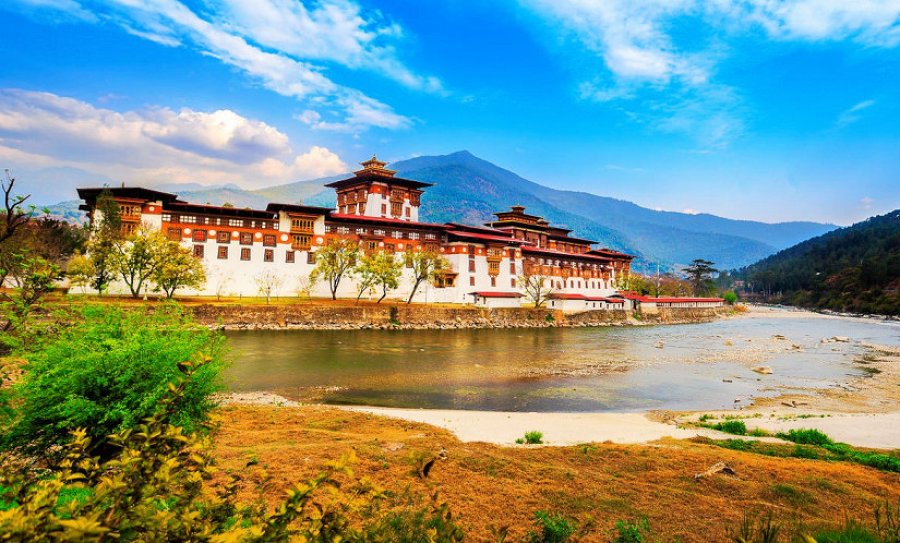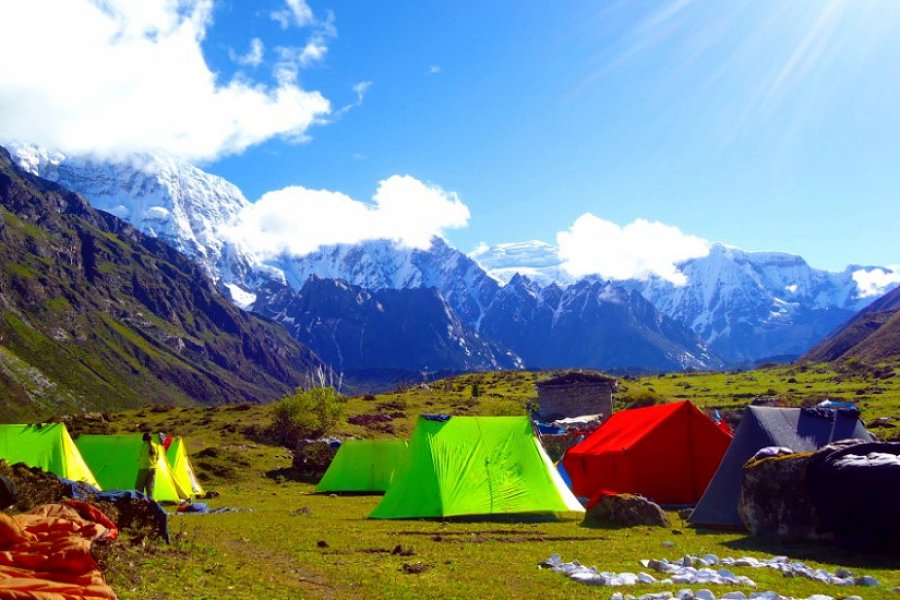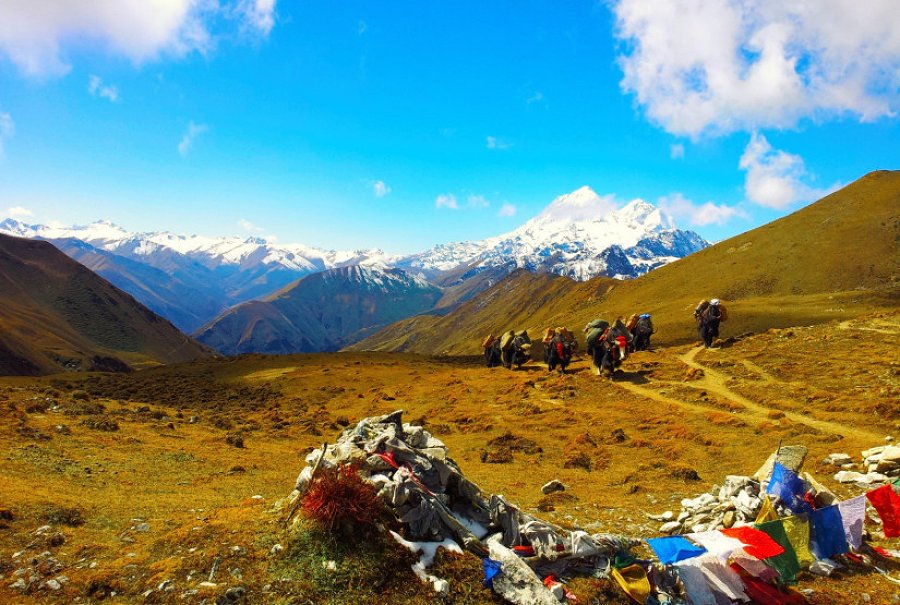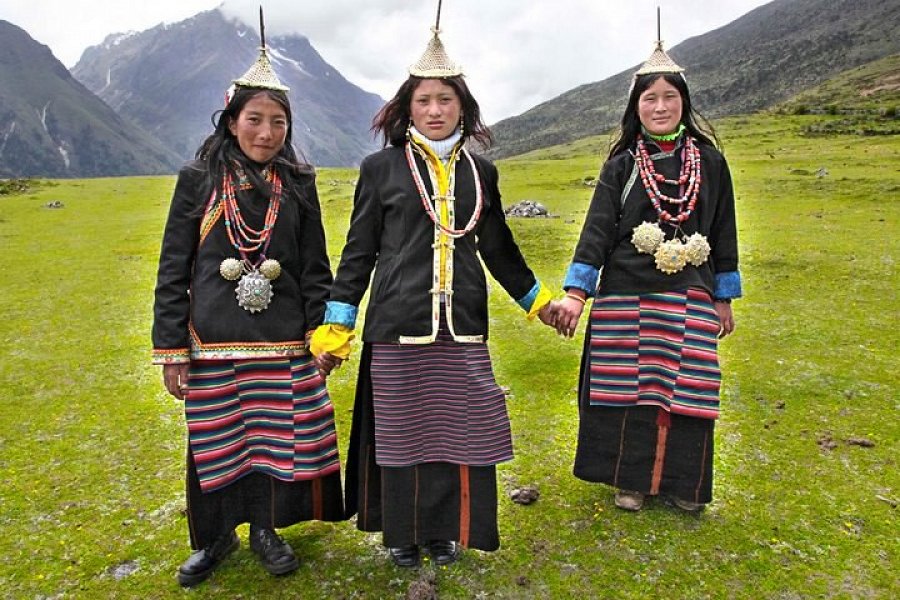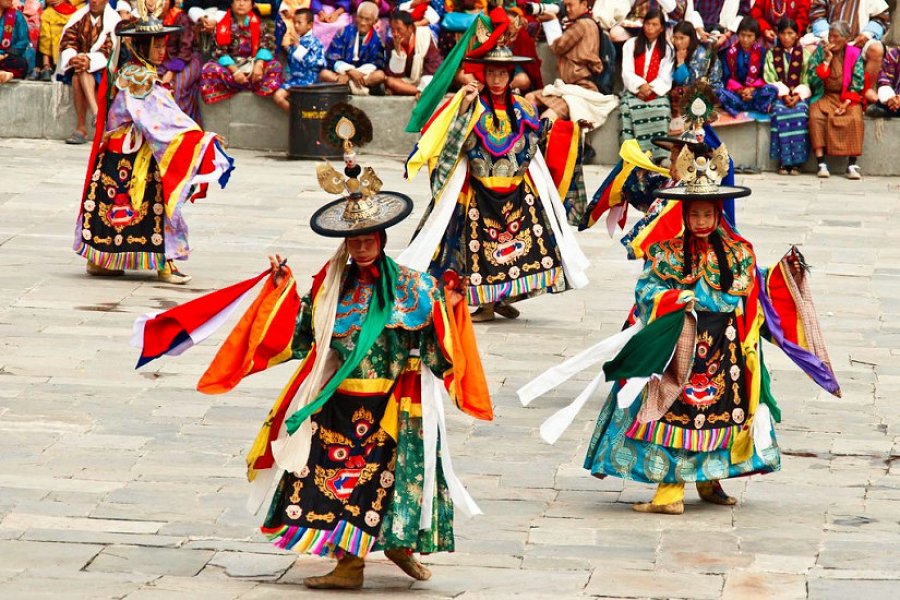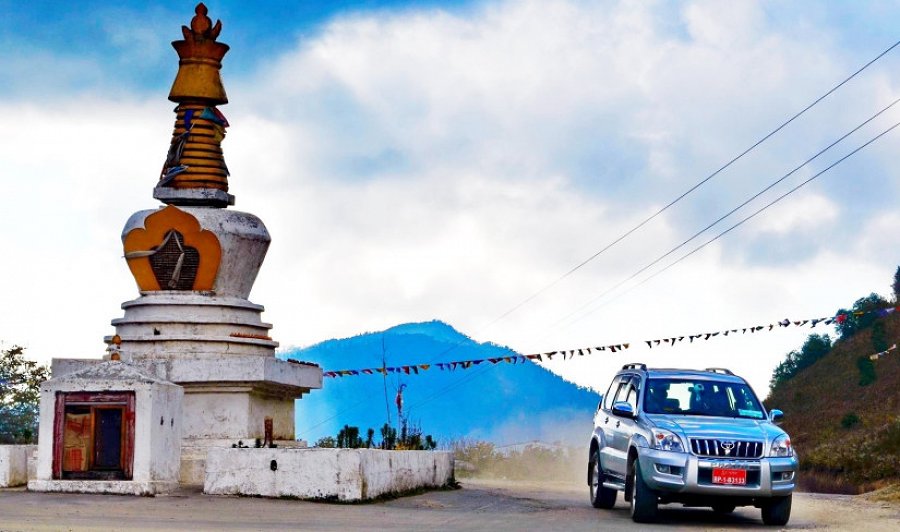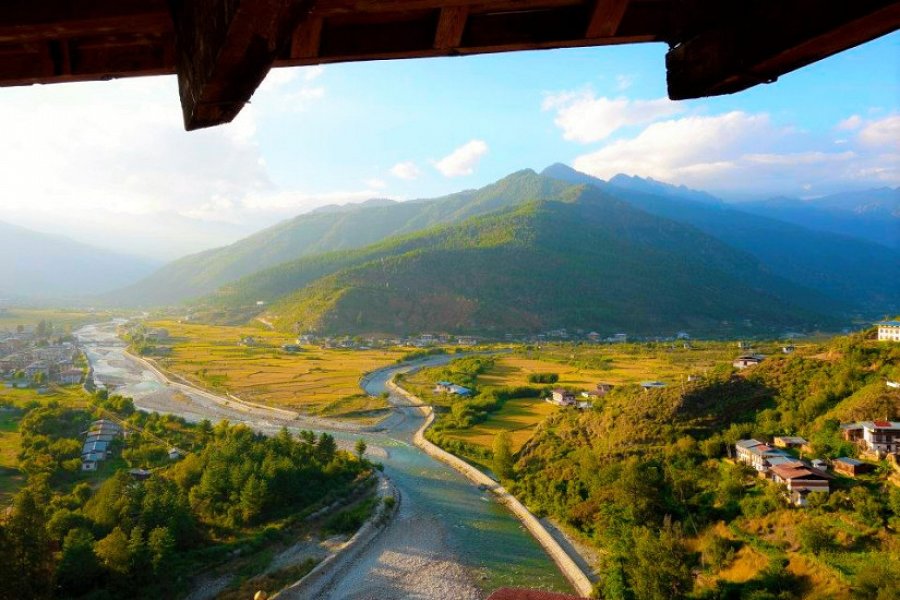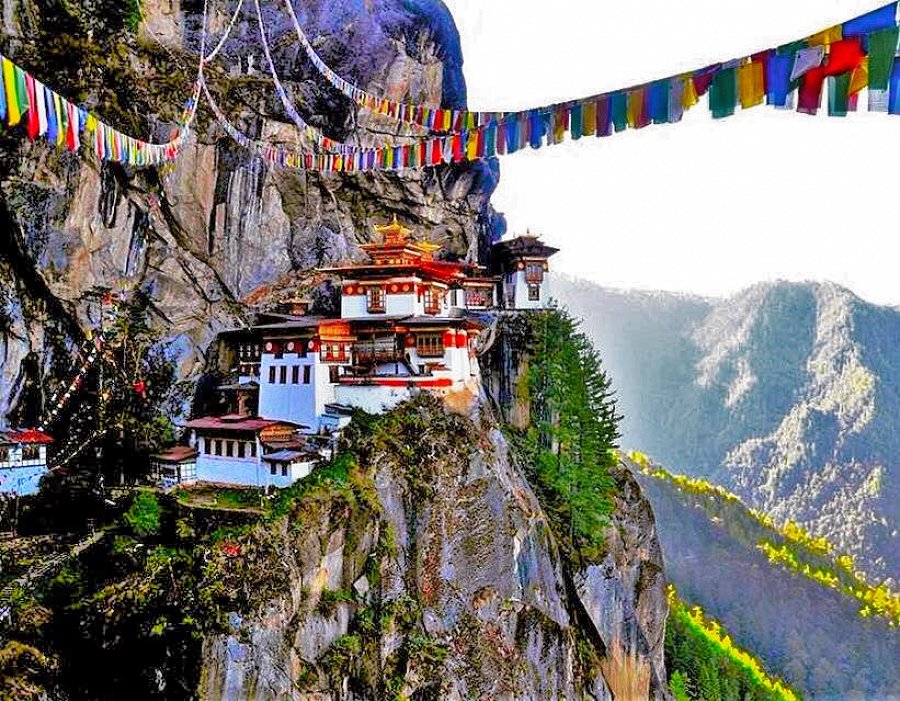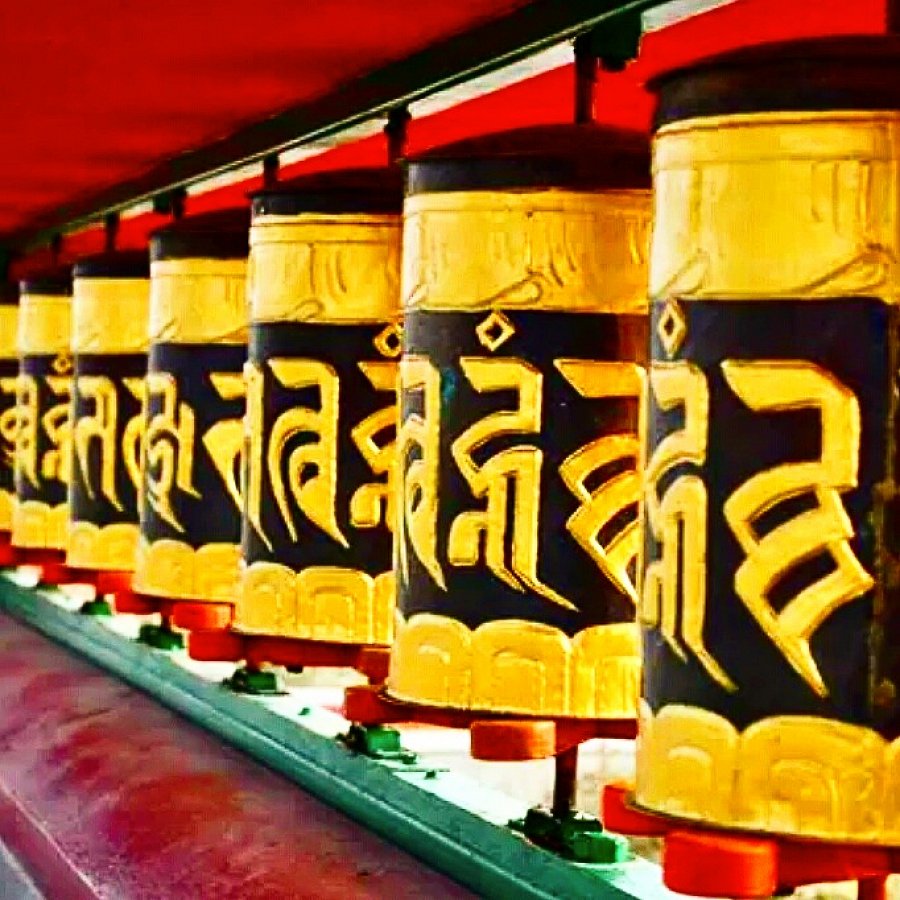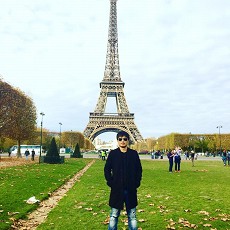My 28 Days Around Bhutan
Published on 18th July, 2017 by Tshering Dorji Bhap
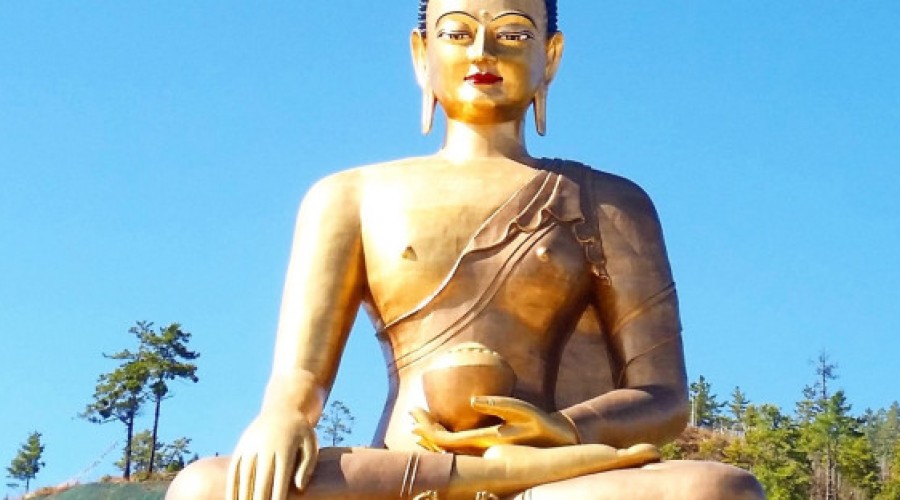
Fly into Paro valley on any of the two national carriers. (DRukair & Bhutan Airlines) You will have glorious view of the snow-capped Himalayas. The remarkable and steep descent into the Paro valley is an awe-inspiring beginning to an adventure of a lifetime. Paro is the gateway to Bhutan, home to the only international airport. This is where you begin the journey to the land of happiness.
Day 01 : Paro – Thimphu
Today’s activities and places to visit:
- Welcome Programs
- Cultural exchange
- Community visit
- Education
- Walk and drive
After visa formalities and collection of baggage, you will be welcomed by the Bhutanese representative from Bhutan Mind Vacation Tours and will drive you to Thimphu, the capital city of Bhutan. The drive takes around an hour following the Wangchu river upwards passing through several villages.
Tachogoenpa monastery dates to the early 15th century built by the saint who is popularly known as the Iron chain maker. To go to the temple, one have to cross an iron bridge dating back to 15th century built by the same saint.
The three forms of chortens (stupas): Bhutanese, Nepalese and Tibetan. These stupas date back to the early 15th century built by the Devine Mad Man.
Arts and Craft Institute is a vocational training institute where the art of painting, woodcraft and sculpturing are taught to students with the objective of preserving the rich and pristine heritage.
The National Library: This repository houses ancient religious and historical manuscripts. If you interested in whetting your intellectual appetite, may do so here.
The Folk Heritage Museum lets you experience the Bhutanese way of living in a very old traditional house.
Weekend market: Friday to Sunday farmers from different place come here to sell their farm product. You get to see the organic farm and wild vegetables and fruits. The other side of the river there are handicraft stalls.
- Distance : 65 kms
- Drive time: 1-2 hrs.
- Overnight at a hotel in Thimphu
Day 02 :Thimphu Halt
Today’s activities and places to visit
- Culture
- Spiritual
- Community visit
- Education
- Leisure
- Hike, walk and drive
Thimphu is the capital city of Bhutan, it combines a natural small-town feel with a new commercial exuberance that constantly challenges the country’s natural conservatism and Shangri La image. Thimphu have some cafes, bars, nightclubs and restaurants. Finding a balance between the esoteric and espresso – the old and the new – is the key to getting the most out of this charming city.
Memorial Chorten was as built in the honor of the late third King of Bhutan, the father of Modern Bhutan, this Chorten is centrally located for young and old people to pray.
Biggest Buddha statue is located at Kuensel Phodrang, the 169 feet bronze statue of Buddha Dordenma, Vajra Throne Buddha symbolizing indestructibility. The Buddha statue itself is competed awaiting paintings, but visitors can drive up to the Buddha point and view the tallest statue of Lord Buddha and the view of Thimphu valley from the Buddha point is spectacular and beautiful.
Bhutan Post: As the sole postal organization of Bhutan, Bhutan Post offers you the finest collections of stamps and post cards. You can purchase the finest stamps and cards as a souvenir. You can also learn about the great messengers and post masters from the past.
Changangkha Lhakhang is the oldest temple in the town which was established in the 12th century. Locals come here to name their children and seek blessings from the protective deity Tamdrin.
Traditional Medicine Center provides medical services, trains traditional doctors, and conducts research on Bhutan’s medicinal plants to identify the ingredients in centuries-old remedies and help develop new health products. The Center has a library of recipes dating back to the introduction of Tibetan Buddhism around 1616, collected from monasteries, which is where most of the medical lore has been retained by educated monks.
Textile Museum displays the finest art of weaving from various regions of Bhutan. You will also be able to see the different fabrics and the intricacies of weaving. There will be a brief audio-visual program on textiles of Bhutan.
Drubthob Gompa Nunnery: Nuns with sport short hair, who play a vital role in the religious affairs of the local community, are enrolled here.
Birds Eye View (Sangaygang) :This view point was once called the lovers point as it offer a very romantic and a breath taking view of the capital city of Bhutan.
Takin preservation center: This place looks like a mini zoo where we preserve the national animal ‘Takin ‘which is a goat antelope and are very rare in the world.
Tashi Cho Dzong was built in the 16th century, it is the largest Dzong and is also the seat of the office of the king. Allowed to visit after office hours and on weekends.
- Distance : 50 Kms
- Drive time: 1hrs
- Overnight at a Hotel in Thimphu
Day 03: Thimphu – Punakha
Today’s activities and places to visit:
- Nature
- Botanical
- Culture
- Spiritual
- Community visit
- Hike, walk and drive
Today is a 3 hours’ drive to Punakha via Dochula pass. Punakha was the capital of Bhutan and the seat of government until 1955, Unlike Thimphu it is quite warm in winter and hot in summer. It is located at an elevation of 1,200 metres above sea level.
Dochula Pass (3100m) :You can get spectacular views of the high Himalayan Mountain ranges. Many colorful prayer flags of good fortune and the marvelous sight of the 108 stupas all together adds to the exotic scenery of the place. A short walk will bring you to Drukwangyal Lhakhang.
Chimmi Lhakhang :This temple is also called fertility temple, and the easy hike passing via the fertile village of Lobesa walking through the paddy fields is one of the best hikes in Bhutan.
Sobsokha village :This is a typical Bhutanese village where you will see the farmers doing their daily activities in their farms and houses.
Punakha Dzong literally meaning the palace of happiness is the most beautiful Dzongs in Bhutan, the Dzong stands on the confluence of two glacial rivers Pho chu and Moo chu , built in the 17th century By the founding father of the nation.
Longest suspension bridge :This is the longest suspension bridge in the whole country. The lives of the farmers across the river has been very convenient after the construction of this bridge.
Khamsum Yuelay Namgyal Chorten was built in 1994 by Her Majesty Azhi Tshering Yangdon Wangchuck for the well-being of the people and country. It’s a moderate hike through the rice paddies and pine forests. The hike takes about 45 minutes one way. The view of the valley from the Choeten is magnificent
- Distance : 89 Kms
- Drive time: 2-3 hrs
- Overnight at a Resort in Punakha.
Day 04: Punakha – Trongsa
Today’s activities and places to visit:
- Nature
- Culture
- Community visit
- Hike, walk and drive
Today is the long drive towards Trongsa. The 5-6 hours’ drive through lush green scenic mountains with spectacular views will cross three high mountains passes, several villages and small towns. Trongsa is the gateway to the center Bhutun.
Chendebji Chorten is situated at the point believed to be where the three ridges and the three edges of the sky meet. It is an important chorten in Bhutan, and is recognizable by its roundish shape and the eyes painted on its sides, which bears similarity to the Jarung Khashor (Bodhanath) stupa in Nepal.
Trongsa town: The name means “new village” in the local language. It is a little beautiful town located right above the Dzong. And is a commercial hub for the people of Trongsa district.
Trongsa Dzong was built in 1648, it was the seat of power over central and eastern Bhutan. Both the first and second kings of Bhutan ruled the country from this ancient seat. All four kings were invested as Trongsa Penlop (“governor”) prior to ascending the throne. The dzong is a massive structure with many levels, sloping down the contours of the ridge on which it is built. Because of the dzong’s highly strategic position, on the only connecting route between east and west, the Trongsa Penlop was able to control effectively the whole of the central and eastern regions of the country from here.
Ta dzong: This watchtower, which once guarded Trongsa Dzong from internal rebellion, stands on a promontory above the town. It was built by Chogyal Minjur Tempa, the 1st Governor of Trongsa in 1652. It has four observation points resembling Tiger, Lion, Garuda, and Dragon. Climb up the path to visit Ta Dzong which now houses a shrine dedicated to the epic hero, King Gesar of Ling. A visit to this former watchtower provides visitors with an insight into the significance of Trongsa in Bhutan’s history. As of date the Ta Dzong of Trongsa is the most fascinating museum of the nation.
- Distance : 129 Kms
- Drive time: 4-5 hrs
- Overnight at a Resort in Trongsa.
Day 5: Trongsa -Tongtongphey-Jangbi Village
Today’s activities and places to visit:
- Nature
- Culture
- Community visit
- Hike, walk and drive
After an early breakfast, a 2-hour drive from the town along the Zhemgang highway brings you to the start of the Trek, Tongtongphey. From Tongtongphey, the village guide steers you down to the Mangde River where you cross a suspension bridge. On this stretch of the journey the rare and endangered Golden Langurs are almost impossible to miss.
Meeting the Monpas who are believed to be the first inhabitants of Bhutan, will give you a first glimpse into their lifestyle and mythical legends about their origin. The campsite in Jangbi stands on the valley sill, which offers a resplendent view of Mangdi valley. A welcome cultural program will be held here to welcome you to their villages.
- Distance: 80 km,
- Drive time: 2hours
- Overnight campsite in the village.
Day 6: Jangbi Village- Kudra Village
Today’s activities and places to visit:
- Nature
- Culture
- Photography
- Community visit
- Hike
The morning allows you to further interact with the Monpas. Before you proceed, you can also pay a visit to the orchid garden that houses around 75 different varieties of orchids. The trail to Kudra is especially interesting as it passes stone imprints of Guru Rinpoche’s footprints, dagger and phallus. Lunch is served just before you arrive at Phrumzur, one of the Monpa villages. After a quick visit to the village Lhakhang in Phrumzur and you then proceed to the campsite in Kudra. En route, you’ll encounter another small Monpa village called Lekpogang, after which, the campsite in Kudra is just an hour’s walk. The campsite offers a bird’s-eye-view of Nyimshong village and of Zhemgang town.
- Distance :13-14.5 km
- Trek time: 6 hours
- Overnight campsite in the village.
Day 7: Kudra Village- Nabji Village
Today’s activities and places to visit:
- Nature
- Culture
- Community visit
- Photography
- Hike
This part of the trek is a collage of streams, waterfalls and thick forests that will give you an invigorating feeling of being out in the wild. Animals such as Himalayan Squirrels, Rhesus Mecaques, and small snakes are often spotted along the trail. Himalayan black bears, Red pandas, tigers and Clouded leopards are also present this region. Upon arrival at the holy tree in Nabji, the villagers will give you a warm reception. Nabji is a beautiful village with paddy fields circling the clustered houses. You can also hike to the community school and enjoy a game of football or volleyball with the local school children.
- Distance: 11-14 km
- Trek time: 5-7 hours
- Overnight campsite in the village.
Day 8: Nabji Village- Korphu Vilage
Today’s activities and places to visit:
- Nature
- Culture
- Community visit
- Photography
- Hike
En route to Korphu, Nabji temple is located amidst verdant paddy fields. Inside, there is a stone pillar on which Guru Rinpoche imprinted the thumbs of two warring kings as a symbol of resolution after bringing about peace. Korphu is situated on a mountaintop at an altitude of 1,500m. The most striking thing about Korphu is that the people exemplify hospitality almost treating you like royalty.
You have the option of being welcomed with a traditional ‘Chipdrel’ procession and a ‘Marchang’ ceremony, singing traditional songs of praise and wellbeing for new visitors. They also perform the traditional ‘Tashi Labey’ dance to bid you farewell.
If interested, participate in the quintessential Bhutanese games of ‘Khuru’, ‘Dego’, ‘Sok-sum’, and ‘Gee-dum.’
Visit the village temple that houses the sacred relics of Pema Lingpa, the famous ‘Treasure revealer’ of Bhutan. A local lunch could be provided in the village campsite which also provides a spectacular bird’s-eye view of Nabji and other surrounding areas.
- Distance: 9.5-13 km
- Trek time: 2-3 hours
- Overnight campsite in the village
Day 9: Korphu Village-Nimshong Village
Today’s activities and places to visit:
- Nature
- Culture
- Community visit
- Photography
- Hike
The hike from Korphu to Nyimshong is pleasant and arguably the best location for bird watching as it is home to over 395 avian species. The elusive Rufous Necked Hornbill has its nesting holes adjacent to the trail. The walk is interspaced with waterfalls and, streams and cantilever bridges. The evening brings you to Nyimshong village. The women of Nyimshong have a penchant for singing and dancing. Tonight, you will enjoy the cultural shows of the village.
- Distance 11-12 km
- Trek time: 4-6 hours
- Overnight campsite in the village.
Day 10: Nimshong village -Trongsa
Today’s activities and places to visit:
- Nature
- Culture
- Community visit
- Photography
- Hike
- Drive
Begin the day by descending towards the Mangdi River. You are likely to see Herons, River-lapwings and even Golden Langurs in this region. A steep hour-long climb will bring you to the road from where your driver will drive you back to Trongsa.
- Distance 90 km,
- Trek time: 2 hours
- Drive time: 3 hours
- Overnight homestay in Trongsa.
Day 11: Trongsa to Bumthang
The 2 hours’ drive through lush green scenic mountains with spectacular views will cross high mountains passes, several villages of Trongsa and Bumthang.
Today’s activities and places to visit:
- Nature
- Botanical
- Culture
- Community visit
- Walk and drive
Yotong la pass takes you over the Black Mountains, the physical boundary between western and central Bhutan. It is 3300 meters above sea levels
Valley of yak herders :As you drive down the valley you will see many yak herders camp and nomad families at work. This place is also a paradise for bird lovers.
Chhumey weaving center is run by a local family. They have an array of famous local sheep-wool textiles.
- Distance: 68 kms
- Drive Time: 2-3 hrs.
- Overnight at a Resort in Bumthang.
Day 12: Bumthang – sightseeing
Bumthang is one of the most beautiful and holiest places in Bhutan. It is home to many of prominent Buddhist temples and monasteries. It’s wide and scenic valleys consists of four main valleys: Ura, Chumey, Tang and Choekhor. The valleys are broad and gentle carved by the ancient glaciers. Here you can get rid of your car after yesterday’s long drive. You can walk and hike in the valley.
Today’s activities and places to visit:
- Nature
- Culture
- Spiritual
- Community visit
- Hike walk and drive
Kurjey Lhakhang complex:This majestic complex is located on the right bank of the Chamkhar River opposite Tamshing and Khonchogsum lhakhang. The Kurje complex is made up of three buildings facing south surrounded by an enclosure made of 108 chortens.
Tamshing Lhakhang is located in a village across the river from Kurjey Lhakhang. It is the seat of Bumthang’s famous son saint Pema Lingpa.
Jakar Dzong is now the seat of district administration and monastic body of Bumthang valley. It is built by the founding father of the nation in the 17th century
Jambay Lhakhang is one of the oldest temples in the kingdom. It was founded by Songtsen Gampo, a Tibetan King in the 7th century AD. The king was destined to build 108 temples known as Thadhul- Yangdhul (temples on and across the border) in a day to subdue the demoness that was residing in the Himalayas. The temple is one of the two of the 108 built in Bhutan. A second is located in Paro, the Kichu lhakhang also built on the same day.
Chamkhar Town :This little beautiful town is the commercial hub for Bumthang district. Here you can find some good local restaurants, bars, cafes and entertainment places.
Konchogsum Lhakhang is located on the left bank of the Chamkhar river opposite Kuje complex and very close to Tamshing temple. This tiny temple is surrounded by an enclosure. Like any ancient temple in the Tibetan cultural area, the sanctuary consists of a small central shrine which may have had a circumambulation path.
Lhodrak Kharchu Goemba :On the hill to the east of Jakar this large Nyingma monastery was founded in the 1970s by Namkhai Nyingpo Rinpoche and has about 400 monks in residence. The Tshokhang (Assembly Hall) has massive statues of Guru Rinpoche, Chenresig and Sakyamuni.
Mebartsho (flaming lake) :In the the early 16th century,Terton Pema Lingpa has discovered the treasure hidden by Guru Rimpoche.
Beer and cheese factory :The factories produce the local cheese and beer. There will be demonstration on the process.
- Distance: 50 Kms
- Drive time 2-3 hrs.
- Overnight at a Resort in Bumthang
Day 13: Chokhor Valley: Nangsiphel/Chokhortoe
Today’s activities and places to visit
- Drive to Nangsiphel
- Hike in Nangsipjel
- Nature Exploration
- Visit WWF initiative sites/programs
- Community Visit (Thangbi,Chokhortoe,Nangsiphel)
Thangbi Monastery was founded by the 4th Shamar Rinpoche in 1470.It is located on a plateau above the Chamkhar river north of Kurje Temple and is now recheable by road. Sheltered in a grove and surrounded by village houses, the main building has two aisles.
Nangsiphel seed center in Bumthang located at an altitude of 2700 meters was established in 1966 for seed potato production.
Dorjibi Weaving Centre also locally known as Thagrig Thuendrel Tshogpa. The centre was built with financial assistance from WWF Bhutan and Elysium Foundation (Helvetas) to enhance rural livelihoods in the buffer zones of Wangchuk Centennial Park. With the support, today, the center has successfully began producing traditional wears (Kabney, Rachu, Kira, Gho) and other items like curtain pieces, shawls etc.
Shugdrak: To get well off the beaten track make the short 10-minute hike up to this sacred Guru Rinpoche cave, 2km past Thangbi. A series of ladders leads pilgrims past a lovely butter-lamp shrine to a rock-face chapel, where a monk can point out the stone footprint, handprint and boot print of the Guru.
- Distance :18-20 kms
- Drive :1 hour
- Trek time: 5-6 hours
- Overnight Farmstay in Nangsiphel
Day 14: Nangsiphel- Tang
Today’s activities and places to visit:
- Hike
- Nature Exploration
- Community Visit
Villages to visit today:
- Drangchel
- Jamzhong
- Mesethang
Tang Ugyen Chholing.
Distance: 12-14 Kms
- Trek time: 6-8 hours
- Drive 0
- Overnight Farmstay in Tang
Day 15 : Tang Valley
Today’s activities and places to visit:
- Hike in Tang Valley
- Nature Exploration
- Community Visit (Thangbi,Chokhortoe,Nangsiphel)
Tang Ugyencholing Museum was originally built by Deb Tsokye Dorje, a descendant of Dorje Lingpa in 16century. The present structure, including the temple, servant’s quarters and a massive residential building, was rebuilt after their collapse in the 1897 earthquake. The complex has been turned into a museum of sorts for religious studies, research and solitude. It exhibits in the main building are captioned with descriptions of the lifestyle and art works of a Bhutanese noble family.
Tang Rimochen Lhakhang marks a sacred place where Guru Rinpoche meditated. A rock in front of the lhakhang has a body-print of the Guru and two consorts. The name Tag Rimoche (an impression of tigers stripes) is derived from the tiger stripes that appear on a rock cliff behind the building. The temple was founded in 14th century by Dorji Lingpa.
- Distance :12- 14 Kms
- Trek time: 6-8 hours
- Drive 0
- Overnight Farm stay in Tang
Day 16: Tang to Ura Valley
Today’s activities and places to visit:
- Drive to Ura
- Hike in Ura valley
- Community Visit (Tang, Ura)
Ura Valley: Located in a broad valley (3100 m), Ura is the highest of the four valleys in Bumthang district. The village of Ura has about 50 or so clusters of traditional homes with cobbled walkways, that gives somewhat a medieval atmosphere. The people of this region are primarily sheep and yak herders.
Ura Temple :The Ura temple was consecrated in 1986 dedicated to Guru Rinpoche. Paintings represent different teachings and are beautifully executed. Phrumsengla National Park Visitor Centre: Here you can gather information about the Protected areas in Bhutan and its Natural Biodiversity.
- Distance :65Kms
- Trek time: 2-3 hours
- Drive :2-3 hours
- Overnight Farm stay in Ura
Day 17: Ura to Mongar
Today’s activities and places to visit:
- Hike in Ura
- Drive to Mongar
- Community Visit
The journey continues eastwards winding through more rugged terrain. The drive withspectacular views will take about 7 hours. Pass through Ura village in Bumthang before climbing sharply to the highest motorable pass in the Kingdom, the Thrumshingla pass (4,000 m). Gradually drop down to Sengor, watching cascading waterfalls on the way.
The descent stops at 700m, on a bridge over the Kurichu. Ascent again through pine forest, maize fields and eastern hamlets to Mongar town.
Mongar dzong :The Mongar Dzong was established in 1930 to replace the original Shongar Dzong, although the original utse (central tower) dates from an earlier age. It’s unusual because it has two entrances. There are four lhakhangs in the utse, including a goenkhang (chapel dedicated to protective deities) and a Sangay Lhakhang.
Wenkhar (community farming center): A typical local farmhouse where you can see the wine being brewed form corn and a traditional Bhutanese way of making a snack from maize, which is their main source of income. The house also showcases the farmer’s day to day life.
- Distance : 190Kms
- Drive :5-6 hours
- Overnight Hotel in Mongar
Day 18: Mongar – Trashigang
Today’s activities and places to visit:
- Nature
- Culture
- Community visit
- Hike, walk and drive
This drive passing through Kori la pass (2,450m), the place marked by a pretty chhorten and a stone wall. The first part of the journey is through leafy forest filled with ferns. Later road descends rapidly through corn fields and banana groves arriving the famous ziazags of Yadi, which is a recent settlement.
Yagang lhakang : Perched on top of a steep hill above the village which is the most important monastery of eastern Bhutan. This is the place of origin of the famous. Drametse Nga Chham, a masked dance with drums.
- Distance : 93 kms
- Drive time : 2-3 hours
- Overnight at the lodge in Trashigang.
Day 19 Trashigang Festival
Today’s activities and places to visit:
- Festival
- Food
- Photography
Trashigang Dzong, standing at the extreme end of the spur, overhanging the Gamri river. It serves as the administrative seat for the district and part of the Dzong is occupied by the Drukpa monastic community.
Today is the festival day, morning drive to Trashigang dzong to witness the Mask dances. This Tsechu Festival is one of the major annual events of eastern Bhutan. The festival holds religious significance and is held to commemorate Guru Rinpoche, who brought tantric Buddhism, also known as Tibetan Buddhism, in Bhutan.The festival comes alive with vibrant colors, music, dances and drama as people gather to enjoy the masked dances, and other sacred rituals. The Tsechu Festival has many local people of the region as well as from different places, arriving at the venue to be a part of the festivities. They come fully clad in their finest attire and jewelry. Dancers dressed in fancy costumes perform masked dances and dramas, seeking to portray Guru Rinpoche, and to celebrate the events in his life. They dance to the beats of trumpets, cymbals, flutes and folksongs, and demonstrate the triumph of good over evil. Trashigang town will be very busy with all the games, food stalls and music shows.
- Distance : 0
- Drive time : 0
Day 20 :Excursion to Trashiyangtse
Today’s activities and places to visit:
- Nature
- Culture
- Spiritual
- Community visit
- Hike walk and drive
Gom Kora : Set on a small alluvial plateau, overlooking the river. Gom Kora is a famous place where Guru Rinpoche subdued a demon.
Doksum village : Here you can see women busy in weaving traditional Bhutanese fabric and a chain bridge dating of the 15th century.
Trashiyangtse dzong: It is situated at the altitude of 1,850m. In former times Trashiyangtse was important center because it lies on one of the carven routes leading from western and center Bhutan.
Chhorten Kora: The stupa was built in the 18th century by Lama Ngawang Lodrö, the nephew of Shabdrung Ngawang Namgyal in order to subdue a harmful demon believed to have been living at the site where the chorten is now located.
- Distance : 105 kms
- Drive time: 3-4 hours
- Overnight at the lodge in Trashigang.
Day 21: Trashigang – Bumthang
Today’s activities and places to visit:
- Nature
- Photography
- Community Visit
- Hike walk and drive
After breakfast drive back to Bumthang with lunch en route.
- Distance: 258 kms
- Drive time: 8-9 hours
- Overnight at a lodge in Bumthang.
Day 22: Bumthang – Trongsa -Phobjikha
Today you will drive to Phobjikha valley. It is famous for Black Necked Cranes. These cranes migrate here from central Asiatic plateau to escape the harsh winter.
It is often called the most beautiful valley in Bhutan. You won’t find trinket shops, museum or places of attractions here. Even the school in the middle of the valley was moved to make way for the Black Necked Cranes conservation area. Today’s activities and places to visit:
- Nature
- Bird watching
- Culture
- Community visit
- Hike, walk, bike and drive
Domkhar Palace is located just above the village of Domkhar on the left bank of the Chhume River, almost facing Tharpaling monastery. It is a short walk from the main road but there is also an access road.The 2nd King Jigme Wangchuck built the Domkhar palace in Chhume valley in 1937 as a summer palace for himself and his elder Queen, Ashi Phuntsho Choeden.
Prakhar is a picturesque village in the Chhume valley, perched on a small plateau located at the curve of the river. The village composed of seven large stone houses, has easy access on foot from the main road.
Gangtey Geomba is an important monastery of Nyingmapa school of Buddhism, the main seat of the Pema Lingpa tradition. The Monastery, also known by the Gangtey village that surrounds it,
Black Necked Crane Center has informative displays about the black-necked cranes and the valley environment. You can use the Centre’s powerful spotting scopes and check what you see against its pamphlet ‘Field Guide to Crane Behavior’
- Distance : 164 kms
- Drive time: 4-5 hrs
- Overnight at a Resort in Phobjikha.
Day 23: Phobjikha – Punakha (Rafting day)
Today’s activities and places to visit: - Drive - Hike - White water rafting
Today, drive to Punakha for rafting. The crystal-clear rivers of Punakha are one of the kingdom’s best kept open secrets. Fed by the glacial-melt of the Eastern Himalayas, Puna Tsang Chhu, have been scouted for kayaking and rafting.
- Distance: 79 kms
- Drive time : 2-3 hours
- Rafting time: 2-3 hours
Day 24: Punakha to Paro
Today’s activities and places to visit:
- Herbal Hot stone bath
- Nature
- Botanical
- Photography
- Community visit
- Hike, walk and drive
Today you will drive to Paro via Thimphu. The charming valley of Paro comprises both the ancient as well as the modern face of Bhutan. Paro is the home to some of the oldest and most revered temple in Bhutan. This is where the famed Tiger Nest Monastery is located.
Bajo town is the commercial center of Wangdue Phodrang
Wangdue Dzong was founded by the Zhabdrung in 1638 atop a high ridge between the Puna Tsang Chhu and the Dang Chhu, clearly chosen for its commanding view of the valleys below.
Lobesa town is located in the juncture of roads from Wangdi and Punakha. The farmers from nearby places come to this little town to sell their farm products and to buy their necessiciteis at home.
Semtokha Dzong was built in 1629 by Zhabdrung Ngawang Namgyal, who unified Bhutan. It is the first of its kind built in Bhutan. I is an important historical monument and former Buddhist monastery.
Local farm house Paro valley is embellished by cluster of farm houses. Bhutanese farm houses are very colorful and traditionally built with mud walls and wooden frame without a single nail. From outside the house looks very big but is quite simple inside. The houses are normally of three stories with the ground floor for the animals, the attic used for the storage of hay. The families live in the middle floor with a chapel for worship which is decorated with paintings. A visit to a farm house is very interesting and offers a good glimpse into the farmers’ lifestyle.
- Distance: 175 kms
- Drive time: 4-5 hrs
- Overnight in Resort at Paro
Day 25: Paro- Haa valley
Today’s activities and places to visit:
- Herbal Hot stone bath
- Nature
- Photography
- Community visit
- Hike, walk and drive
Today, drive to Haa valley vai Chelala Pass– the highest pass accessible by motor road (3990 meters). Here you will enjoy the magnificent view of the Mt. Jhomolhari (7300m). You will also be able to spot the Tiger’s Nest and also the beautiful views of two districts Paro and Haa. Do a short hike, 10 meters ascending to make it 4000 meters above sea level. Enjoy a cup of hot tea and snacks on the highest point. After the short hike continue your drive, an hour descend will bring you to beautiful Haa valley.
Black and the White temples: These two temples are some of the oldest temples in Bhutan built in the 8th century.
Haa Dzong is currently headquarters for Border Road Organization. Beautiful town of Haa : Unlike other towns, Haa town is full of traditional old buildings and is one of the least developed towns in Western Bhutan. Explore the town and overnight in a guest house in Haa.
- Distance: 70 kms
- Drive time: 2-3 hrs
- Overnight in Resort at Haa
Day 26: Haa – Paro
Today’s activities and places to visit:
- Herbal Hot stone bath
- Nature
- Photography
- Community visit
- Hike, walk and drive
After breakfast, you will drive back to Paro.
Kila Gompa Nunnery: Here a lot of nuns come to seek for serious spiritual path of life. You will see a lot of meditation huts and caves
Dzongdra temple: It is a master piece of its own, a Cliffside temple where you get opportunity to get blessed from the relics. The temple consists of four shrines and the valley view from the temple is breath taking. Today you will have your hot packed lunch somewhere on the route with beautiful views.
Holy medicinal water : Local believes that this water can cure a lot of diseases.
Paro town: There are lot of things to do in Paro, try the cafes, bars and entertainment places in the town or go to a house museum, you can also try our traditional game- Archery.
- Distance: 70 kms
- Drive time: 2-3 hours
- Overnight in a Resort at Paro.
Day 27: -Paro – Hike to The Tiger’s Nest (Taktsang)
Today is the big day, hike to the famous Tiger’s Nest. A one-hour hike will bring you to to the cafeteria, stop for a cup of tea and toilet break. The cafeteria offers you the stunning view of the monastery, prayer flags adorn the cliffs. Your lunch will be served in the cafeteria on your way back. It is usually a day’s hike but if you are still left with some time and energy after the hike you can visit the following places of interest.
Today’s activities and places to visit:
- Farewell
- Cultural Shows
- Nature
- Spiritual
- Community visit
- Hike and drive
Tiger’ Nest Legend has it that Guru Rimpoche flew from Eastern Bhutan on a tigress, bringing Buddhist teachings and meditated here in a cave on this cliff for three months. This is one of the most venerated and sacred of all Buddhist sights around the world.
Kichu Lhakhang :The Jowo Temple of Kyichu is one of the oldest temples in Bhutan, originally built in the 7th century by the Tibetan Emperor Songtsan Gampo. It is considered to be one of the four (4) border taming temples he built.
Drukgyal dzong :The fortress was built in 1649 by Zhabdrung Nawang Namgyel to commemorate his victory over the Tibetan invaders, led by Mongolian warlord Gushi Khan in 1644. Strategically built over the only passage into Paro valley, the dzong helped repel numerous invasions all through the course of Bhutanese history. It so impressed early visitors that in 1914 the dzong featured on the cover of the National Geographic Magazine. Unfortunately, the dzong was gutted by accidental fire in 1951. The ruin, as it stands today, still attract tourists. On a clear day one can see the commanding view of Mt. Jomolhari from the village nestle below the Dzong.
Paro Rimpung :The Fortress on a heap of Jewels was built in 1646 by Zhabdrung Nawang Namgyel. The approach to the dzong is through a traditional roofed wooden bridge and a walk through the stone inlaid path offer a good view of the architectural wonder of the dzong as well as life around it. The Dzong now houses the state monastic school and the civil administration of Paro region. It is also the venue for the Paro Tsechu (festival) held once a year in spring.
Ta Dzong (National Musuem) Looking down over the Rimpung Dzong, the Ta-Dzong (watch tower) was built in 1651, unlike the rectangular shape of dzongs, it is round more like parts of a European castle. Since 1967 the watchtower was transformed into the National Museum and holds a fascinating collection of arts, relics and thangka
- Distance : 40 kms
- Drive time: 1 hrs
- Overnight in a Resort at Paro
Day 28 : Paro – Departure
After the breakfast BMV representatives will bid a fond farewell to the magical kingdom in the sky and wish you happy journey back home. Depart for Paro airport for your onward flight with full of Bhutanese NOSTALGIA.
- Distance : 15 Km
- Drive time: 10 mins

